key SKODA YETI 2011 1.G / 5L Columbus Navigation System Manual
[x] Cancel search | Manufacturer: SKODA, Model Year: 2011, Model line: YETI, Model: SKODA YETI 2011 1.G / 5LPages: 47, PDF Size: 1.09 MB
Page 30 of 47

MAP mode
Map display Fig. 10 Map display with split-screen in
the compass display.
– Press the button MAP .
■ - maps goes to full-screen display
■ Change the display type
■ -2D - 2D display
■ -3D - 3D display
■ -Topograph. - Plan view of 2D map display with coloured display of various
terrains (Mountains, Valleys etc.)
■ Function key
“Navigation” - the menu is dependent on the operating type of
the route guidance ⇒ page 29, Function key “Navigation”
■ A - indicates which source medium is currently active
■ choose another radio station from the memory
■ - pressing briefly changes to the beginning of the current title, repeated
pressing changes to the beginning of the previous title.
■ - brief pressing changes over to the beginning of the next title.
■ - the play function is stopped in the current position and the symbol
changes to - after pressing
the play function continues in this posi-
tion.
■ In the menu Systems Setup if the time display is activated ⇒
page 12, Setup
System, at position A the current time is displayed. ■
Extras ■
Destination view - shows the currently selected travel destination in the map
display in the main menu Navigation. Use the function key on the right un-
der the compass display to center the map again on the vehicle position.
■ Split-screen - the menu is dependent on the operating type of the route
guidance ⇒ page 30, Function key
“Split-screen”
■ Day/night - changes between day and night design.
■ POI selection - selects points of interest category, which is displayed on the
map using symbols ⇒ page 12,
Setup Map
■ Lane guidance - during route guidance, when driving and turning on roads
with more than one lane, a small split-screen with lane guidance will be in-
serted in the map display.
■ Switch off display - it is possible to switch the display to energy saving mode-
the display goes black and the current information about the audio source
is shown in the bottom row. The display can be switched on again by
touching the display or by pressing any button, except the control button 1 Change the map scale and display
Pressing the function key with the display of the currently selected map dimen-
sion at the bottom right will insert further function keys for changing the map de-
tail and the map scale. If not used, these function keys fade out again after a few
seconds.
- briefly switches the map display to the overview display (small scale). It re-
turns again to the last display (large scale) after a few seconds.
+ or
- - to zoom in or out of the map, i.e.changing the map scale. Alternatively,
move the sliding regulator within the scale.
- changes to the overview map with start and finish point during route guid-
ance.
- If Autozoom is active, the map scale will change automatically depending on
the driven route (Motorway trip: large map scale - city: The switched-on Autozoom
is displayed in the scale display by . You can switch off the Autozoom again by
pressing the scale again or manually with the button 8 .
Moving the map section using the vehicle position or destination
You can move the indicated map section by pressing your finger on the touch-
screen and sliding it over the touchscreen. 28
MAP mode
Page 31 of 47

Function keys and symbols during route guidance
- current vehicle position
- centres the map section using the vehicle position
- centres the map section using the destination
Ð
Function key “Navigation” Fig. 11 3D map display during the route
guidance
Depending on the type of route guidance, various function keys appear at position A .
Operating mode: Route guidance switched off Navigation■
Start route guidance - starts route guidance or continues route guidance to the
travel destination selected in the main menu Navigation.
■ Enter new destination - calls up the menu
New dest. to change the travel destina-
tion selected in the main menu Navigation ⇒ page 34,
The function key “New
dest.”.
■ Route options - changes the defaults for the route calculation
⇒
page 34,
Function key “Options”
■ - saves current vehicle position to the destination memory as a flagged des-
tination
Operating mode: Route guidance with the destination
.../ ...
- distance to the destination
- expected time of arrival in the destination or driving time ■
Stop route guidance - stops route guidance at the current position. The route
guidance can be continued at any time by pressing the function key Navigation and
Start route guidance .
■ Enter stopover destination - calls up the menu
New dest. in order to enter a stop-
over to be approached during current route guidance ⇒ page 34, The func-
tion key “
New dest.”.
■ Congestion ahead - used for the manual entry of a congestion ahead and the rec-
ommendation of the next available route ⇒ page 38, Manually excluding
stretches of the journey
■ Route options - changes the defaults for the route calculation
⇒
page 34,
Function key “Options”
■ - saves current vehicle position to the destination memory as a flagged des-
tination
Operating mode: Route guidance with stopover destinations
...
/ ... ,
...
/
...
- distance to the destination
- distance to the stopover destination
- expected time of arrival in the destination or driving time
■ Stop route guidance - stops route guidance at the current position. The route
guidance can be continued at any time by pressing the function key Navigation and
Start route guidance .
■ Enter stopover destination - calls up the menu
New dest. in order to enter a stop-
over to be approached during current route guidance ⇒ page 37,
Function
keys “Extras”.
■ Congestion ahead - used for the manual entry of a congestion ahead and the rec-
ommendation of the next available route ⇒
page 38, Manually excluding
stretches of the journey
■ Route options - changes the defaults for the route calculation
⇒
page 34,
Function key “Options”
■ save - saves current vehicle position to the destination memory as a flagged
destination
■ Tour plan - displays tour plan
Waypoint navigation Waypoint navigation ■
Waypoint tour - Enter the starting point of the waypoint navigation
■ Turn around waypt tour - travel route in the reverse direction
■ From the closest - Waypoint navigation from the nearest waypoint
29
MAP mode
Page 32 of 47

■
Select waypoint - waypoint navigation from the selected waypoint
■ From the first - Waypoint navigation from the first waypoint
■ Enter new destination - enter destination on a street- waypoint navigation is quit
Ð
Function key “Split-screen” Fig. 12 The split-screen with the display of the navigation information/split-screen with the
display of the information list
Various function keys are displayed in the separate navigation types here.
■ Compass - displays compass display with current direction of travel
■ Pos. map - displays map display with the vehicle position. Press once on the
map in the split-screen to change the map display.
■ GPS Viewer - shows the coordinates of the current vehicle position. The number
of satellites received will also be displayed. At least five satellites must be re-
ceived simultaneously to enable the absolute height above sea level to be dis-
played behind the mountain symbol (Display:
“3D Fix”).
■ Dest. guidan. symbol - displays the symbol of the next destination guidance ma-
noeuvre
■ Manoeuvre list - displays the manoeuvre list
■ Overview - displays map display with the removal between the vehicle position
and destination
■ Tour plan - displays tour plan
Ð30
MAP mode
Page 34 of 47
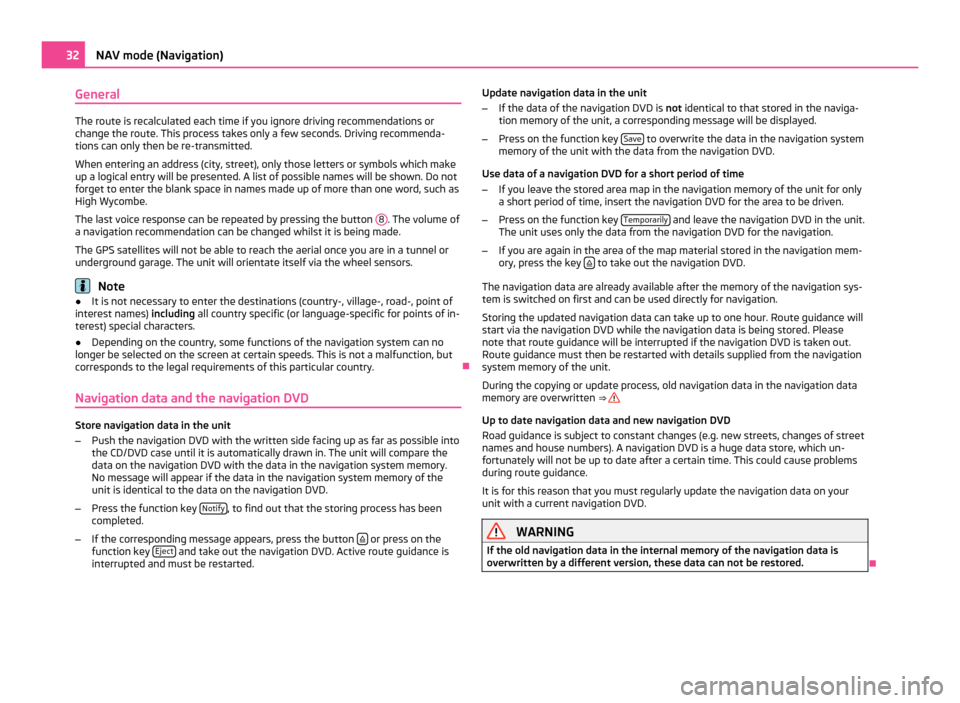
General
The route is recalculated each time if you ignore driving recommendations or
change the route. This process takes only a few seconds. Driving recommenda-
tions can only then be re-transmitted.
When entering an address (city, street), only those letters or symbols which make
up a logical entry will be presented. A list of possible names will be shown. Do not
forget to enter the blank space in names made up of more than one word, such as
High Wycombe.
The last voice response can be repeated by pressing the button 8 . The volume of
a navigation recommendation can be changed whilst it is being made.
The GPS satellites will not be able to reach the aerial once you are in a tunnel or
underground garage. The unit will orientate itself via the wheel sensors. Note
● It is not necessary to enter the destinations (country-, village-, road-, point of
interest names) including all country specific (or language-specific for points of in-
terest) special characters.
● Depending on the country, some functions of the navigation system can no
longer be selected on the screen at certain speeds. This is not a malfunction, but
corresponds to the legal requirements of this particular country. Ð
Navigation data and the navigation DVD Store navigation data in the unit
–
Push the navigation DVD with the written side facing up as far as possible into
the CD/DVD case until it is automatically drawn in. The unit will compare the
data on the navigation DVD with the data in the navigation system memory.
No message will appear if the data in the navigation system memory of the
unit is identical to the data on the navigation DVD.
– Press the function key Notify , to find out that the storing process has been
completed.
– If the corresponding message appears, press the button or press on the
function key Eject and take out the navigation DVD. Active route guidance is
interrupted and must be restarted. Update navigation data in the unit
–
If the data of the navigation DVD is not identical to that stored in the naviga-
tion memory of the unit, a corresponding message will be displayed.
– Press on the function key Save to overwrite the data in the navigation system
memory of the unit with the data from the navigation DVD.
Use data of a navigation DVD for a short period of time
– If you leave the stored area map in the navigation memory of the unit for only
a short period of time, insert the navigation DVD for the area to be driven.
– Press on the function key Temporarily and leave the navigation DVD in the unit.
The unit uses only the data from the navigation DVD for the navigation.
– If you are again in the area of the map material stored in the navigation mem-
ory, press the key to take out the navigation DVD.
The navigation data are already available after the memory of the navigation sys-
tem is switched on first and can be used directly for navigation.
Storing the updated navigation data can take up to one hour. Route guidance will
start via the navigation DVD while the navigation data is being stored. Please
note that route guidance will be interrupted if the navigation DVD is taken out.
Route guidance must then be restarted with details supplied from the navigation
system memory of the unit.
During the copying or update process, old navigation data in the navigation data
memory are overwritten ⇒
Up to date navigation data and new navigation DVD
Road guidance is subject to constant changes (e.g. new streets, changes of street
names and house numbers). A navigation DVD is a huge data store, which un-
fortunately will not be up to date after a certain time. This could cause problems
during route guidance.
It is for this reason that you must regularly update the navigation data on your
unit with a current navigation DVD. WARNING
If the old navigation data in the internal memory of the navigation data is
overwritten by a different version, these data can not be restored. Ð32
NAV mode (Navigation)
Page 35 of 47
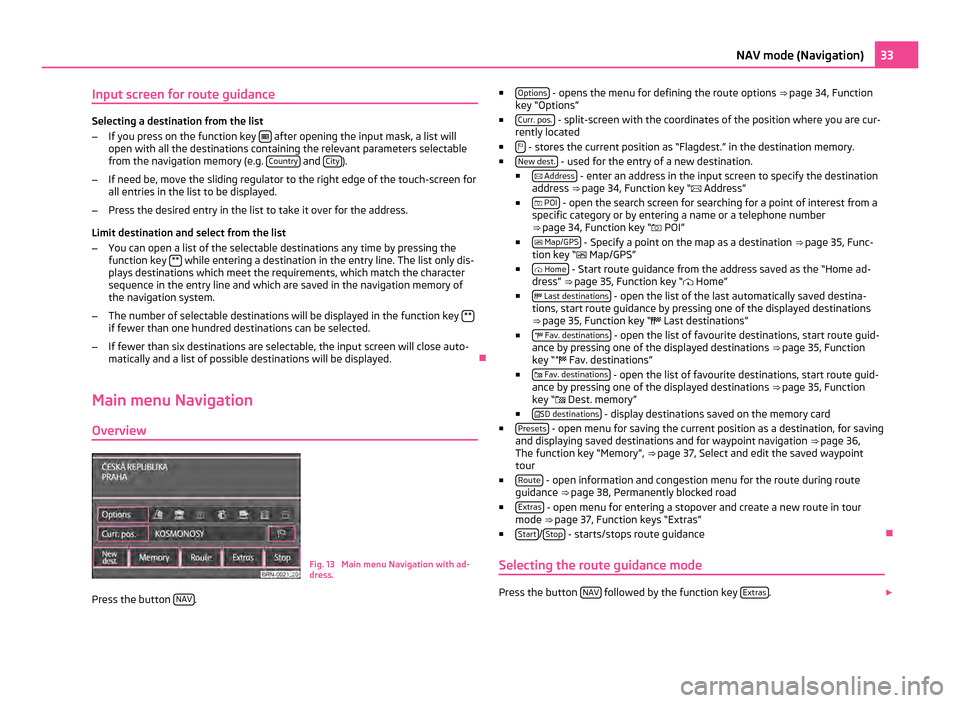
Input screen for route guidance
Selecting a destination from the list
–
If you press on the function key after opening the input mask, a list will
open with all the destinations containing the relevant parameters selectable
from the navigation memory (e.g. Country and
City ).
– If need be, move the sliding regulator to the right edge of the touch-screen for
all entries in the list to be displayed.
– Press the desired entry in the list to take it over for the address.
Limit destination and select from the list
– You can open a list of the selectable destinations any time by pressing the
function key ** while entering a destination in the entry line. The list only dis-
plays destinations which meet the requirements, which match the character
sequence in the entry line and which are saved in the navigation memory of
the navigation system.
– The number of selectable destinations will be displayed in the function key **if fewer than one hundred destinations can be selected.
– If fewer than six destinations are selectable, the input screen will close auto-
matically and a list of possible destinations will be displayed. Ð
Main menu Navigation
Overview Fig. 13 Main menu Navigation with ad-
dress.
Press the button NAV . ■
Options - opens the menu for defining the route options
⇒ page 34, Function
key “Options”
■ Curr. pos. - split-screen with the coordinates of the position where you are cur-
rently located
■ - stores the current position as “Flagdest.” in the destination memory.
■ New dest. - used for the entry of a new destination.
■ Address - enter an address in the input screen to specify the destination
address ⇒ page 34, Function key
“ Address”
■ POI - open the search screen for searching for a point of interest from a
specific category or by entering a name or a telephone number
⇒ page 34, Function key
“ POI”
■ Map/GPS - Specify a point on the map as a destination
⇒
page 35, Func-
tion key “ Map/GPS”
■ Home - Start route guidance from the address saved as the “Home ad-
dress
” ⇒ page 35, Function key “ Home”
■ Last destinations - open the list of the last automatically saved destina-
tions, start route guidance by pressing one of the displayed destinations
⇒
page 35, Function key “ Last destinations”
■ Fav. destinations - open the list of favourite destinations, start route guid-
ance by pressing one of the displayed destinations
⇒ page 35, Function
key “ Fav. destinations”
■ Fav. destinations - open the list of favourite destinations, start route guid-
ance by pressing one of the displayed destinations
⇒ page 35, Function
key “ Dest. memory”
■ SD destinations - display destinations saved on the memory card
■ Presets - open menu for saving the current position as a destination, for saving
and displaying saved destinations and for waypoint navigation ⇒ page 36,
The function key “Memory”
, ⇒ page 37, Select and edit the saved waypoint
tour
■ Route - open information and congestion menu for the route during route
guidance ⇒
page 38, Permanently blocked road
■ Extras - open menu for entering a stopover and create a new route in tour
mode ⇒ page 37,
Function keys “Extras”
■ Start /
Stop - starts/stops route guidance
Ð
Selecting the route guidance mode Press the button
NAV followed by the function key
Extras .
33
NAV mode (Navigation)
Page 36 of 47
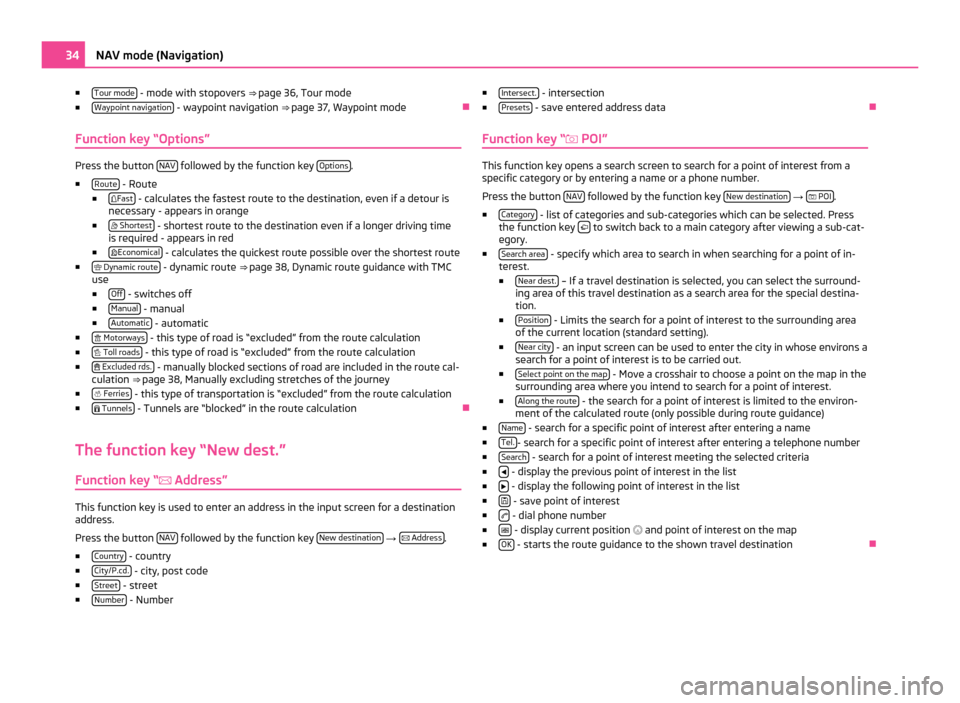
■
Tour mode - mode with stopovers
⇒ page 36, Tour mode
■ Waypoint navigation - waypoint navigation
⇒ page 37, Waypoint mode Ð
Function key “Options” Press the button
NAV followed by the function key
Options .
■ Route - Route
■ Fast - calculates the fastest route to the destination, even if a detour is
necessary - appears in orange
■ Shortest - shortest route to the destination even if a longer driving time
is required - appears in red
■ Economical - calculates the quickest route possible over the shortest route
■ Dynamic route - dynamic route
⇒
page 38, Dynamic route guidance with TMC
use
■ Off - switches off
■ Manual - manual
■ Automatic - automatic
■ Motorways - this type of road is “excluded” from the route calculation
■ Toll roads - this type of road is “excluded” from the route calculation
■ Excluded rds. - manually blocked sections of road are included in the route cal-
culation ⇒ page 38, Manually excluding stretches of the journey
■ Ferries - this type of transportation is “excluded” from the route calculation
■ Tunnels - Tunnels are “blocked” in the route calculation
Ð
The function key “New dest.”
Function key
“ Address”This function key is used to enter an address in the input screen for a destination
address.
Press the button NAV followed by the function key
New destination →
Address .
■ Country - country
■ City/P.cd. - city, post code
■ Street - street
■ Number - Number ■
Intersect. - intersection
■ Presets - save entered address data
Ð
Function key “ POI” This function key opens a search screen to search for a point of interest from a
specific category or by entering a name or a phone number.
Press the button NAV followed by the function key
New destination →
POI .
■ Category - list of categories and sub-categories which can be selected. Press
the function key to switch back to a main category after viewing a sub-cat-
egory.
■ Search area - specify which area to search in when searching for a point of in-
terest.
■ Near dest. – If a travel destination is selected, you can select the surround-
ing area of this travel destination as a search area for the special destina-
tion.
■ Position - Limits the search for a point of interest to the surrounding area
of the current location (standard setting).
■ Near city - an input screen can be used to enter the city in whose environs a
search for a point of interest is to be carried out.
■ Select point on the map - Move a crosshair to choose a point on the map in the
surrounding area where you intend to search for a point of interest.
■ Along the route - the search for a point of interest is limited to the environ-
ment of the calculated route (only possible during route guidance)
■ Name - search for a specific point of interest after entering a name
■ Tel. - search for a specific point of interest after entering a telephone number
■ Search - search for a point of interest meeting the selected criteria
■ - display the previous point of interest in the list
■ - display the following point of interest in the list
■ - save point of interest
■ - dial phone number
■ - display current position
and point of interest on the map
■ OK - starts the route guidance to the shown travel destination
Ð34
NAV mode (Navigation)
Page 37 of 47
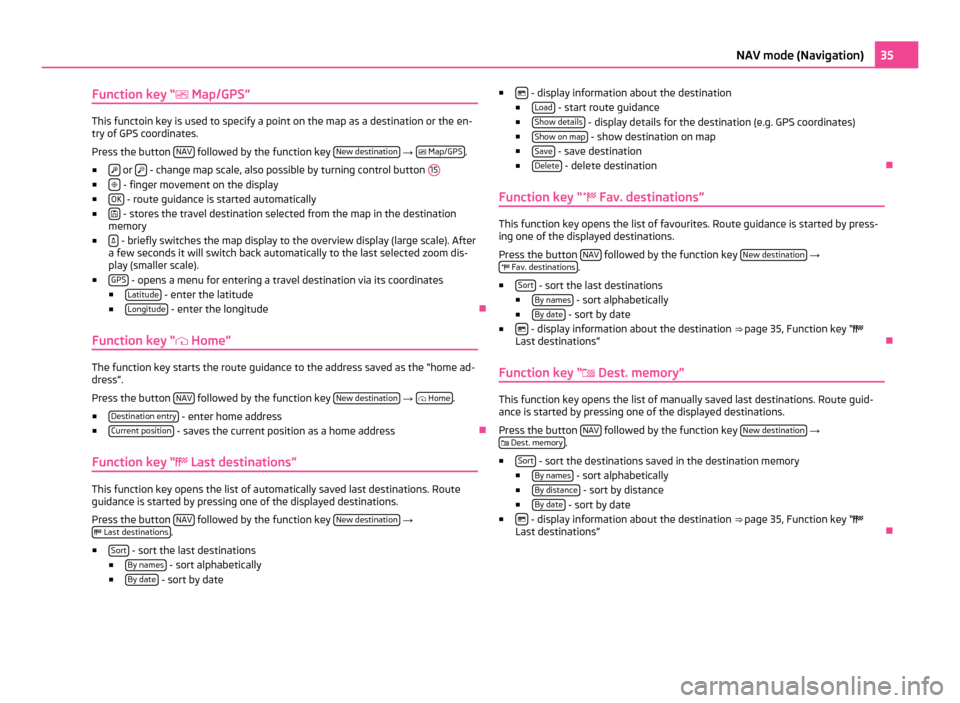
Function key “ Map/GPS”
This functoin key is used to specify a point on the map as a destination or the en-
try of GPS coordinates.
Press the button NAV followed by the function key
New destination →
Map/GPS .
■ or
- change map scale, also possible by turning control button
15■
- finger movement on the display
■ OK - route guidance is started automatically
■ - stores the travel destination selected from the map in the destination
memory
■ - briefly switches the map display to the overview display (large scale). After
a few seconds it will switch back automatically to the last selected zoom dis-
play (smaller scale).
■ GPS - opens a menu for entering a travel destination via its coordinates
■ Latitude - enter the latitude
■ Longitude - enter the longitude
Ð
Function key “ Home ”The function key starts the route guidance to the address saved as the
“home ad-
dress
”.
Press the button NAV followed by the function key
New destination →
Home .
■ Destination entry - enter home address
■ Current position - saves the current position as a home address
Ð
Function key “ Last destinations” This function key opens the list of automatically saved last destinations. Route
guidance is started by pressing one of the displayed destinations.
Press the button NAV followed by the function key
New destination →
Last destinations .
■ Sort - sort the last destinations
■ By names - sort alphabetically
■ By date - sort by date ■
- display information about the destination
■ Load - start route guidance
■ Show details - display details for the destination (e.g. GPS coordinates)
■ Show on map - show destination on map
■ Save - save destination
■ Delete - delete destination
Ð
Function key “ Fav. destinations” This function key opens the list of favourites. Route guidance is started by press-
ing one of the displayed destinations.
Press the button NAV followed by the function key
New destination →
Fav. destinations .
■ Sort - sort the last destinations
■ By names - sort alphabetically
■ By date - sort by date
■ - display information about the destination
⇒ page 35, Function key
“
Last destinations” Ð
Function key “ Dest. memory
” This function key opens the list of manually saved last destinations. Route guid-
ance is started by pressing one of the displayed destinations.
Press the button NAV followed by the function key
New destination →
Dest. memory .
■ Sort - sort the destinations saved in the destination memory
■ By names - sort alphabetically
■ By distance - sort by distance
■ By date - sort by date
■ - display information about the destination
⇒
page 35, Function key “
Last destinations” Ð 35
NAV mode (Navigation)
Page 38 of 47
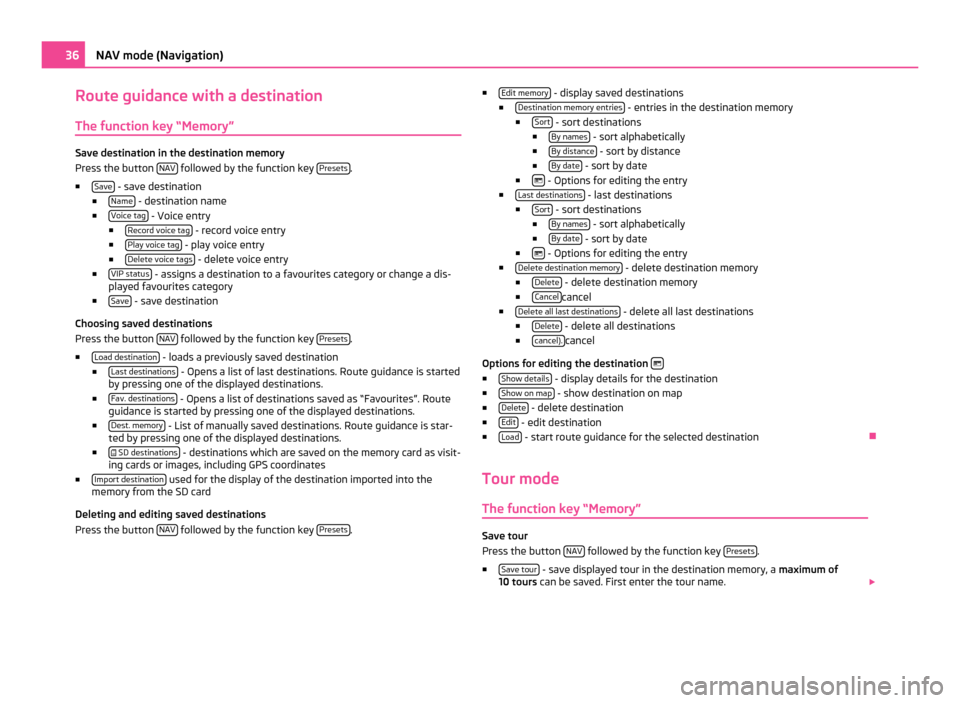
Route guidance with a destination
The function key “Memory”Save destination in the destination memory
Press the button
NAV followed by the function key
Presets .
■ Save - save destination
■ Name - destination name
■ Voice tag - Voice entry
■ Record voice tag - record voice entry
■ Play voice tag - play voice entry
■ Delete voice tags - delete voice entry
■ VIP status - assigns a destination to a favourites category or change a dis-
played favourites category
■ Save - save destination
Choosing saved destinations
Press the button NAV followed by the function key
Presets .
■ Load destination - loads a previously saved destination
■ Last destinations - Opens a list of last destinations. Route guidance is started
by pressing one of the displayed destinations.
■ Fav. destinations - Opens a list of destinations saved as “Favourites”. Route
guidance is started by pressing one of the displayed destinations.
■ Dest. memory - List of manually saved destinations. Route guidance is star-
ted by pressing one of the displayed destinations.
■ SD destinations - destinations which are saved on the memory card as visit-
ing cards or images, including GPS coordinates
■ Import destination used for the display of the destination imported into the
memory from the SD card
Deleting and editing saved destinations
Press the button NAV followed by the function key
Presets .■
Edit memory - display saved destinations
■ Destination memory entries - entries in the destination memory
■ Sort - sort destinations
■ By names - sort alphabetically
■ By distance - sort by distance
■ By date - sort by date
■ - Options for editing the entry
■ Last destinations - last destinations
■ Sort - sort destinations
■ By names - sort alphabetically
■ By date - sort by date
■ - Options for editing the entry
■ Delete destination memory - delete destination memory
■ Delete - delete destination memory
■ Cancel cancel
■ Delete all last destinations - delete all last destinations
■ Delete - delete all destinations
■ cancel). cancel
Options for editing the destination ■
Show details - display details for the destination
■ Show on map - show destination on map
■ Delete - delete destination
■ Edit - edit destination
■ Load - start route guidance for the selected destination
Ð
Tour mode The function key
“Memory” Save tour
Press the button
NAV followed by the function key
Presets .
■ Save tour - save displayed tour in the destination memory, a
maximum of
10 tours can be saved. First enter the tour name. 36
NAV mode (Navigation)
Page 39 of 47
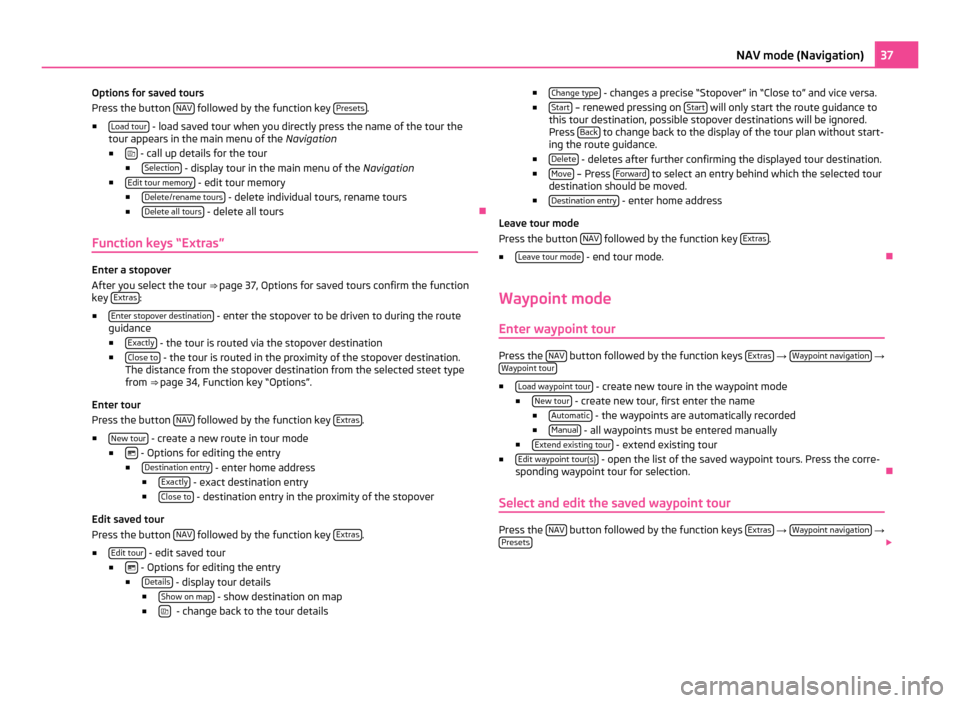
Options for saved tours
Press the button
NAV followed by the function key
Presets .
■ Load tour - load saved tour when you directly press the name of the tour the
tour appears in the main menu of the Navigation
■ - call up details for the tour
■ Selection - display tour in the main menu of the
Navigation
■ Edit tour memory - edit tour memory
■ Delete/rename tours - delete individual tours, rename tours
■ Delete all tours - delete all tours
Ð
Function keys “Extras” Enter a stopover
After you select the tour
⇒ page 37
, Options for saved tours confirm the function
key Extras :
■ Enter stopover destination - enter the stopover to be driven to during the route
guidance
■ Exactly - the tour is routed via the stopover destination
■ Close to - the tour is routed in the proximity of the stopover destination.
The distance from the stopover destination from the selected steet type
from ⇒
page 34, Function key “Options”.
Enter tour
Press the button NAV followed by the function key
Extras .
■ New tour - create a new route in tour mode
■ - Options for editing the entry
■ Destination entry - enter home address
■ Exactly - exact destination entry
■ Close to - destination entry in the proximity of the stopover
Edit saved tour
Press the button NAV followed by the function key
Extras .
■ Edit tour - edit saved tour
■ - Options for editing the entry
■ Details - display tour details
■ Show on map - show destination on map
■ - change back to the tour details ■
Change type - changes a precise “Stopover” in “Close to” and vice versa.
■ Start – renewed pressing on
Start will only start the route guidance to
this tour destination, possible stopover destinations will be ignored.
Press Back to change back to the display of the tour plan without start-
ing the route guidance.
■ Delete - deletes after further confirming the displayed tour destination.
■ Move – Press
Forward to select an entry behind which the selected tour
destination should be moved.
■ Destination entry - enter home address
Leave tour mode
Press the button NAV followed by the function key
Extras .
■ Leave tour mode - end tour mode.
Ð
Waypoint mode Enter waypoint tour Press the
NAV button followed by the function keys
Extras →
Waypoint navigation →
Waypoint tour ■
Load waypoint tour - create new toure in the waypoint mode
■ New tour - create new tour, first enter the name
■ Automatic - the waypoints are automatically recorded
■ Manual - all waypoints must be entered manually
■ Extend existing tour - extend existing tour
■ Edit waypoint tour(s) - open the list of the saved waypoint tours. Press the corre-
sponding waypoint tour for selection. Ð
Select and edit the saved waypoint tour Press the
NAV button followed by the function keys
Extras →
Waypoint navigation →
Presets 37
NAV mode (Navigation)
Page 40 of 47

■
Load waypoint tour - open the list of the saved waypoint tours. Press the corre-
sponding waypoint tour for selection.
■ Edit waypoint tour memory - open waypoint tour memory. . Stored waypoint tours
can be displayed, renamed or deleted.
■ Edit waypoint tour(s) - open the list of the saved waypoint tours. Press the
corresponding waypoint tour for selection.
■ Delete waypoint tours - delete waypoint tours
Ð
Leave tour mode Press the
NAV button followed by the function keys
Extras →
Waypoint navigation →
New destination ■
Onroad destination - terminates the waypoint nav. and opens the menu
New
dest. for selection of an “Onroad destination ” from the available navigation da-
ta.
■ Back - switches back into the waypoint nav.
Ð
Manually excluding stretches of the journey Temporarily blocked road
A temporarily blocked road is only taken into account in the current route guid-
ance.
Press the function key
.../ ... during the route guidance.
→ Congestion ahead . An
overview map will be displayed together with the current vehicle position and
the travel destination .
Turn the set button 8 anti-clockwise, move a flag symbol
starting from the
travel destination in direction of the current vehicle position. Use the finger to
press on the displayed route and the flag symbol will
“skip” directly to this
point. The distance taken up by the current congestion will be displayed as of the
current vehicle position at the bottom in the touch-screen.
Press the set button or the function key OK , when the approximate length of the
stretch of the road to be bypassed is displayed.
You will receive an audible announcement that parts of the route are blocked and
that the alternative route is being calculated.
Received TMC traffic reports will be displayed in the map as traffic problems. Cur-
rently announced traffic problems can also be displayed in the list of TMC traffic
reports. Permanently blocked road
A permanently blocked road is taken into account during each route destination
cycle.
Press the function key
Route →
Manage blocked routes in the main menu
Navigation
during route guidance.
■ Add excluded street section - add an additional blocked section to the route . Lo-
cate the start of the congestion by pressing on the route indicated on the
touch-screen and confirm it by pressing the function key OK . The end of the
congestion is set in the same way.
■ Delete excluded street section - delete the blocked street sections from the memo-
ry in the navigation system
■ Delete temporarily blocked road. - deletes the congestion entered with the button
Congestion ahead Ð
Dynamic route guidance with TMC use Switching the dynamic navigation on or off
–
In the main menu Navigation press on the function key Options .
– In the map display, press the button Navigation or on
.../ ... during a route
guidance and on Route options in the pop-up window.
– In the menu Route options , press on the function key
Dynamic route and se-
lect the desired set-up by pressing your choice in the pop-up window.
– Confirm the settings with the function key OK .
Traffic problems received via TMC which affect the route are displayed in the map
by means of a coloured symbol. Traffic problems, which do not affect the route,
are displayed in the map by means of a grey symbol. The direction in which a traf-
fic problem is found, is displayed by means of an arrow in the symbol. The duration
of a traffic problem on the route is displayed in the map by means of continuous
PKW (motor car) symbols .
Off You are not alerted to received traffic disruptions along your route and are guided
through the traffic disruption by the navigation system. TMC traffic reports are
however still updated automatically in the unit. They can be displayed by pressing
the range selector key TMC .
38
NAV mode (Navigation)